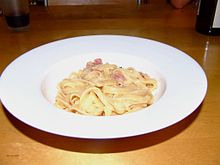Carbonara
Carbonara is a pasta dish made from pasta with guanciale , egg , pepper and cheese from the Italian region of Lazio . Today it is one of the classics of Italian cuisine .
History of origin
According to a widespread legend , the dish goes back to Köhler / coal merchants, in Italian carbonari , who are said to have cooked penne (short tubular noodles) with bacon and grated cheese in the Apennines during work breaks . Alla carbonara means “ in the way of Koehler ”. It is often assumed that the name was derived from one of the two traditional Roman restaurants called La Carbonara , but this version is denied by the restaurants themselves.
According to La Cucina Romana e del Lazio (2013), carbonara was probably only created after 1944 when the Allies captured Rome , from a combination of the egg, powdered egg and bacon rations of American soldiers with Italian culinary culture. Evidence of names and recipes can only be found since the post-war period.
preparation
To prepare the original recipe, the pasta is boiled. Spaghetti are the most common, but there are also fettuccine , rigatoni , linguine or bucatini used. Guanciale is cut into fine strips and gently fried in a little olive oil , pecorino grated and beaten with egg. The pasta is mixed with the bacon, some of the cooking water from the pasta and the cheese-egg mixture and freshly ground pepper. The heated, but not boiled, cheese and egg mixture forms a creamy sauce when properly prepared.
Variations
Instead of guanciale, other mixed bacon such as pancetta is often used in Italy . Parmesan or Grana Padano is also often used instead of or mixed with Pecorino.
The pasta with boiled ham and cream, which is often offered outside of Italy as “spaghetti alla carbonara”, does not correspond to the Italian original in terms of ingredients and preparation.
Web links
Individual evidence
- ↑ in the Roman dialect, carbonaio becomes carbonaro
- ^ Alan Davidson, The Oxford Companion to Food, 2nd. ed. Oxford 2006, article Spaghetti , p. 740
- ↑ La Carbonara in via Panisperna
- ↑ La Carbonara al Campo de 'Fiori
- ↑ Livio Jannattoni: La Cucina Romana e del Lazio . Newton Compton, Roma 2013, ISBN 978-88-541-5865-8 .
- ^ Academia Italiana della Cucina
- ↑ Video on the preparation of spaghetti alla carbonara in the traditional Trattoria Da Danilo in Rome on YouTube
- ↑ Video on how to prepare three different types of carbonara on Youtube
- ↑ Recipe for Classic Italian Spaghetti Carbonara ( Memento from August 7, 2016 in the Internet Archive )

